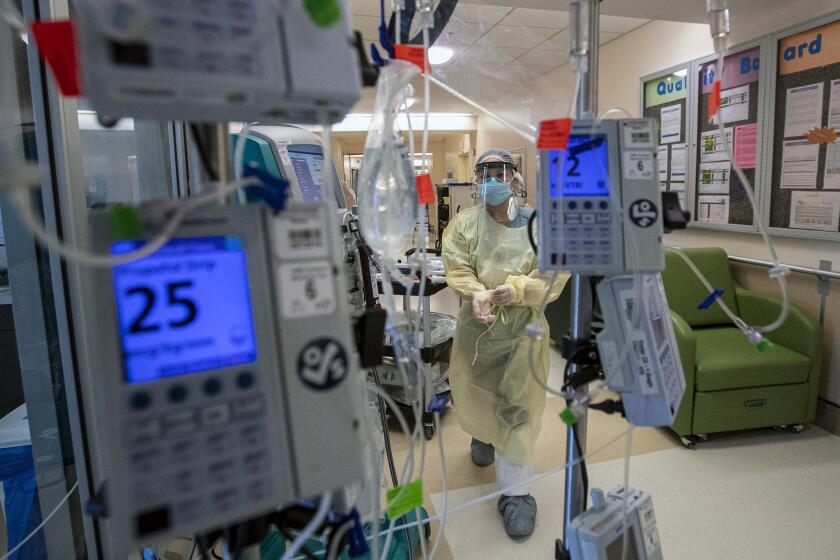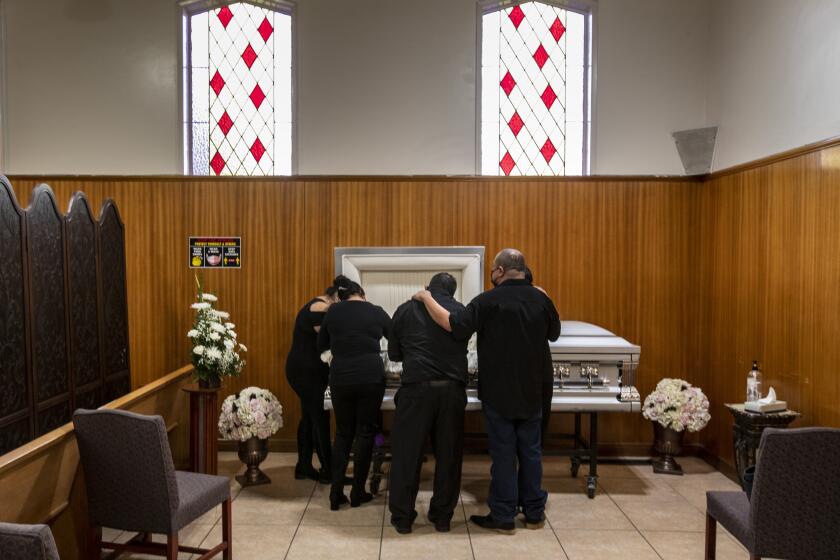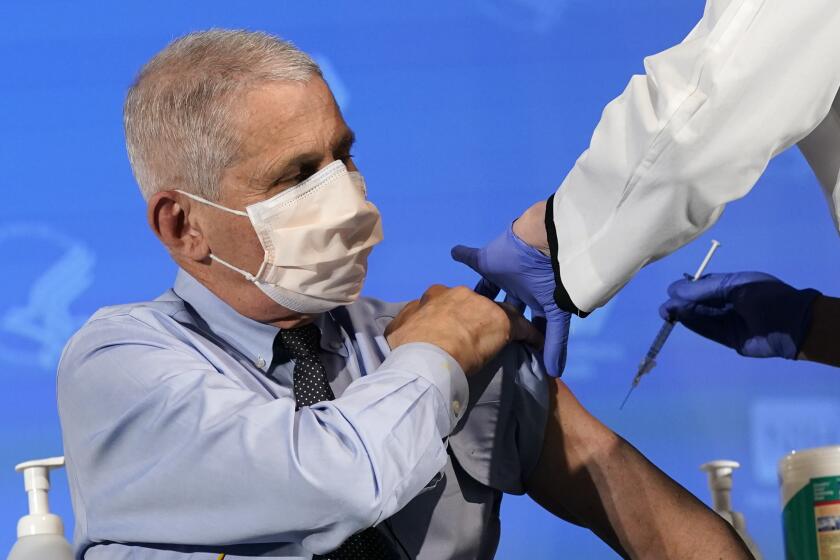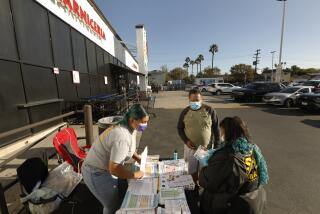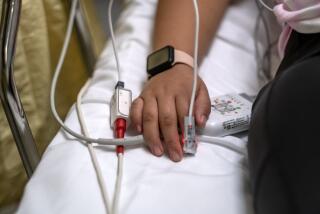Ambulance crews told not to transport patients who have little chance of survival

- Share via
The situation in Los Angeles County hospitals is so critical that ambulance crews have been advised to cut back on their use of oxygen and to not bring to hospitals patients who have virtually no chance of survival. Officials say they need to focus on patients with a greater chance of surviving.
The measures were taken as circumstances are expected to become even worse in coming weeks, when patients sickened over the Christmas holiday will need treatment, leaving officials desperate for ways to increase capacity and triage care to focus on the sickest patients.
Already, “many hospitals have reached a point of crisis and are having to make very tough decisions about patient care,” said Dr. Christina Ghaly, the L.A. County director of health services.
“The volume being seen in our hospitals still represents the cases that resulted from the Thanksgiving holiday,” she added during a briefing Monday. “We do not believe that we are yet seeing the cases that stemmed from the Christmas holiday. This, sadly, and the cases from the recent New Year’s holiday, is still before us, and hospitals across the region are doing everything they can to prepare.”
California received about 1.3 million doses, but only about 454,000 people have received the vaccine, Gov. Gavin Newsom said Monday.
Throughout the coronavirus-clobbered county, hospitals are moving to rapidly discharge ill patients who, in normal situations, would stay for continued observation. That has helped, but officials fear the flood of new patients — many with COVID-19 — is outpacing their ability to move less critical patients out.
In a sign of the strain the surge is putting on medical supplies needed for severely ill patients, the L.A. County Emergency Medical Services Agency issued a directive Monday that ambulance crews should conserve oxygen by administering it only to patients who have oxygen saturation levels below 90%. To reduce demand on hospitals, the agency issued memos directing ambulance staff not to transfer to hospitals most patients who have virtually no chance of survival.
In pre-pandemic times, those with slim odds of pulling through were transported to the hospital, as there was capacity to accommodate even the most unlikely recovery scenarios.
Patients who are not to be transported to hospitals include those whose hearts have stopped and, despite efforts at resuscitation, have no signs of breathing, movement, a pulse or blood pressure and would be declared dead at the scene. Paramedics and emergency medical technicians are to continue to try to resuscitate in the field until a pulse can be restored, after which a patient could be stabilized and transported to a hospital.
“It’s mentally, physically and emotionally draining,” said Dr. Nick Kwan, who struggled to articulate the toll that COVID-19 has placed on patients and L.A. County hospitals.
Emergency rooms are so slammed that some patients are having to wait inside ambulances for as long as eight hours before a bed becomes available. That backlog ties up ambulances and keeps them from being able to respond to other emergency calls.
To deal with the shortage, officials have devised an emergency plan to create temporary “ambulance-receiving spaces” — set up just outside the emergency room entrance and often covered by tents or canopies — to accept patients.
A paramedic or emergency medical technician may be used to assist with monitoring up to four patients in such areas, a change from the conventional practice of having one patient monitored by one ambulance staff member. Officials say the plan allows more ambulances to leave the hospital and return to circulation.
An ambulance-receiving space can be implemented only with permission from the L.A. County Emergency Medical Services Agency’s Medical Alert Center. The threshold is met only when all available patient treatment areas in the emergency room — including hallways — are fully occupied and when at least three ambulances or at least three patients managed by EMTs or paramedics must wait for more than an hour.
The additional measures illustrate the lengths to which hospitals in California’s most-populous county are going to contend with the crush of COVID-19 patients.
As of Sunday, the most recent day for which complete data are available, there were 7,898 coronavirus-positive patients hospitalized countywide; 1,627 were in intensive care.
Officials remain concerned that the numbers — already at all-time highs — will surge even more by the end of this week or early next week, although case reports may be lower over the next few days because fewer people were tested over the holidays.
“We’re likely to experience the worst conditions in January that we’ve faced the entire pandemic, and that’s hard to imagine,” L.A. County Public Health Director Barbara Ferrer said.
The number of COVID-19 patients hospitalized will continue to rise “as long as our case numbers increase,” she said during a briefing Monday, and county health officials have said they expect that travel and gatherings over the holiday season will trigger another surge of new patients.
“Everyone should keep in mind that community transmission rates are so high that you run the risk of an exposure whenever you leave your home,” Ferrer said. “Assume that this deadly, invisible virus is everywhere, looking for a willing host. Don’t let that be you or someone you care about.”
One of the largest hospitals in San Bernardino County ran out of ICU space two weeks ago amid an onslaught of coronavirus cases across Southern California.
The pandemic’s toll on healthcare systems throughout L.A. County and California as a whole was evidenced further Monday, when Gov. Gavin Newsom unveiled an oxygen strategy to beef up the state’s reservoir of resources and provide assistance and other support to hard-hit areas that desperately need the vital therapeutic.
As part of that effort, California has created a state oxygen team, and the Army Corps of Engineers has sent specialized crews to update oxygen-delivery systems at a handful of L.A. County’s aging hospitals.
The state is also working to augment support for home oxygen usage so some patients can recover outside of a hospital setting — allowing for “more availability and more capacity within our existing facilities,” Newsom added.
“We’re just looking at the panoply of oxygen support … across the spectrum and looking how we can utilize more flexibility and broader distribution of these oxygen units all up and down the state, but particularly in these areas — San Joaquin Valley and Los Angeles, the larger Southern California region — that are in particular need and are under particular stress,” he said.
Dr. Jeffrey Gunzenhauser, L.A. County’s chief medical officer, said the state had eased some administrative requirements on hospitals, such as the amount of charting required, to free staff so they can take care of more patients.
“We are exploring, collectively, every possible way to reduce the burden on the hospitals,” he said. “There’s a lot of actions that have been taken to improve the coordination of identifying patients really needing hospitalization and linking them up to where there’s an available bed, rather than stacking up ambulances outside an emergency department.”
Officials are also working on identifying and removing barriers to discharging patients to lower levels of care.
“For example, there are beds available in some skilled nursing facilities,” Gunzenhauser said, “and we are doing everything possible to remove restrictions so patients who are well enough to be discharged from hospitals can move to those skilled nursing facilities.”
Such facilities have been the site of coronavirus outbreaks, but Gunzenhauser said officials are “trying to set it up so it could be as safe as possible in regards to COVID transmission.”
Patients who could be moved might include those who have suffered a heart attack or stroke and don’t need to stay in the hospital but must receive intense nursing support, he said. Such arrangements make more sense than setting up a field hospital or medical ship, as was done earlier in the pandemic, because the medical infrastructure and staff are already in place, he said.
“If you set up a tent or have a ship, you have to build everything else around it,” he noted.
The goal, Gunzenhauser said, is to keep hospitals in L.A. County from entering “crisis care” mode, in which medical rationing would occur.
“But if there is a surge in cases, there could be an additional 1,000 beds or more needed for COVID patients, which would be difficult to accommodate here in L.A.,” he said. “It’s hard to speculate, but we’re doing all we can to prepare for the worst.”
Workplaces remain an area of growing concern, amid new outbreaks at retail establishments as well as other businesses deemed essential.
L.A. County’s ICUs are bursting at the seams. The number of COVID-19 patients in ICUs nearly tripled in December, even as hospitals cut in half the number of ICU patients who were not coronavirus-positive. But that comes at a cost. For instance, one patient with a kidney transplant scheduled for mid-January at Cedars-Sinai Medical Center had his procedure postponed because of a lack of ICU beds.
On Wednesday, of the more than 2,000 occupied ICU beds in L.A. County, 77% were used by COVID-19 patients. That’s a marked increase from Dec. 1, when 37% of ICU beds had COVID-19 patients.
Many hospitals are reporting their ICUs as effectively full and have been forced to treat dying patients in emergency rooms and even hallways. On Wednesday, only 25, or 1%, of the county’s staffed ICU beds were available.
That same day, there were no available ICU beds in the San Gabriel Valley or southeast Los Angeles County. There were only three beds in southern L.A. County, representing less than 1% of all staffed ICU beds in a region that includes Long Beach and the South Bay.
Between Christmas and Dec. 28, there were no ICU beds available in central L.A., home to Cedars-Sinai Medical Center near Beverly Hills and L.A. County-USC Medical Center on the Eastside. On Dec. 26, there was only one ICU bed available on the Westside, a region that includes Ronald Reagan UCLA Medical Center in Westwood and Providence Saint John’s Health Center in Santa Monica.
On Sunday, an additional 11,513 new coronavirus cases were reported in the county, according to a Times count of local health jurisdictions. Over the last three days, L.A. County has reported an average of 16,000 new coronavirus cases a day, among the highest numbers of the pandemic.
An additional 85 COVID-19 deaths were reported Sunday. This follows grim numbers last week: 242 deaths on Tuesday, 262 on Wednesday, 291 on Thursday and 193 on Friday, New Year’s Day.
Over the last week, the average deaths per day was 184, the highest number on record — the equivalent of a death every eight minutes.
A bleak new threshhold of 350,000 deaths is reached. Despite Trump’s claims, Fauci says the toll ‘not fake.’
January will be “the darkest month we will have,” L.A. Mayor Eric Garcetti said Sunday.
In another worrying trend, Garcetti said, more people who do not have underlying health conditions are dying of COVID-19. Earlier in the pandemic, about 92% of those who died had preexisting health conditions; that number has dropped to about 86%, officials said.
“So, my message to everybody is, this is not only going to come for somebody that you love, this is going to possibly come for you,” Garcetti said Sunday on CBS’ “Face the Nation.” “And so everything we do is either lifesaving or life-taking at this point.”
More to Read
Sign up for Essential California
The most important California stories and recommendations in your inbox every morning.
You may occasionally receive promotional content from the Los Angeles Times.


